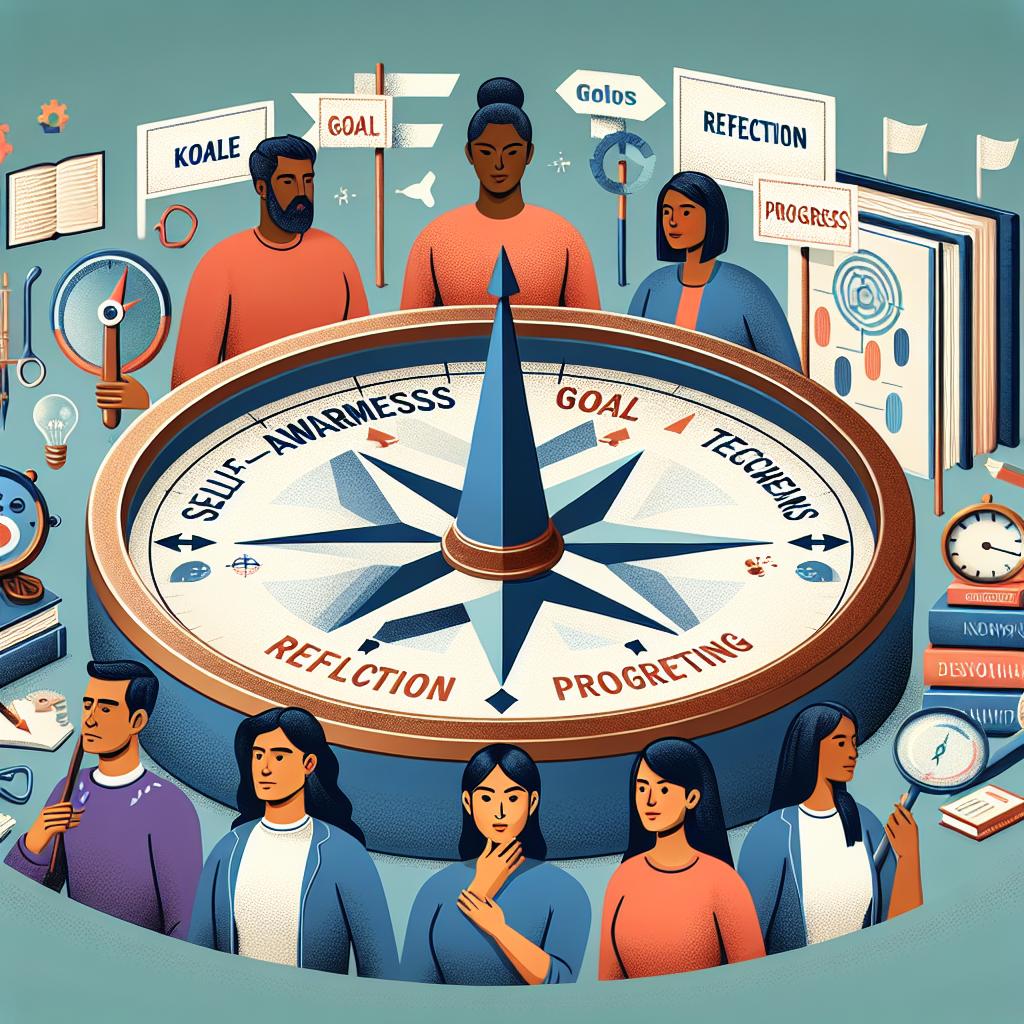Self-Reflection and Personal Growth Plans

In the bustling symphony of modern life, where every moment seems a race against the clock, finding a quiet corner to pause and reflect can seem like a luxurious, even unattainable, dream. Yet, amidst this relentless pace, there lies an age-old truth: the seeds of our greatest growth are planted not in the flurry of action, but in the stillness of introspection. Welcome to a journey that delves into the transformative power of self-reflection and the art of crafting personal growth plans. Here, we explore how these twin pillars can guide us through the maze of our ambitions and anxieties, bringing clarity, direction, and a renewed sense of purpose. Join us as we uncover the profound simplicity of looking inward, and the structured promise of mapping our inner aspirations onto the canvas of everyday life.
Table of Contents
- Discovering the Core: Unearthing Your True Self
- Charting Your Journey: Effective Self-Assessment Techniques
- Unlocking Potential: Setting Realistic and Ambitious Goals
- Building Your Pathway: Crafting a Personalized Growth Plan
- Embracing Change: Implementing and Adapting Your Strategy
- Reflect and Refine: Continuous Improvement Through Self-Evaluation
- Q&A
- In Conclusion

Discovering the Core: Unearthing Your True Self
Embark on a profound journey within, peeling back the layers to reveal the essence of who you are. This process involves asking yourself deep, purposeful questions that challenge the superficial and focus on the **inner truths**. Engage in practices such as **journaling**, where you freely explore thoughts and emotions. Meditation and mindfulness can also be powerful tools, allowing you to connect with your subconscious mind, creating space for clarity and insight. Additionally, consider seeking feedback from trusted friends or mentors who can provide a reflective mirror to your self-perception.
**Creating a Personal Growth Plan** is another vital step in unearthing your true self. Start by identifying areas where you seek improvement or growth. Break these down into manageable goals and actionable steps. You can use tools like vision boards to visually map out your ambitions and plans. Here’s a simple table to help organize your thoughts:
| Goal | Steps | Timeline |
|---|---|---|
| Improve Physical Health |
|
3 months |
| Learn a New Skill |
|
6 months |
Regularly revisiting and adjusting your plan can keep you aligned with your evolving self, ensuring that your inner journey is both intentional and transformative.

Charting Your Journey: Effective Self-Assessment Techniques
When aiming to understand and develop one’s self, leveraging **effective self-assessment techniques** can be incredibly empowering. These methods offer insights into both strengths and areas for improvement, paving the way for more informed personal growth plans. Consider incorporating these strategies into your routine:
- **Journaling**: Regularly jotting down thoughts and experiences can help capture patterns and pivotal moments.
- **Mind Mapping**: Visually organize your goals and ideas to uncover connections and inspire new paths forward.
- **Feedback Loops**: Soliciting feedback from trusted friends or mentors can provide external perspectives and highlight blind spots.
To ensure you’re progressing towards your goals, staying organized with a personal growth plan is crucial. Below is a simplified template to help structure your journey:
| Goal | Action Steps | Timeline | Success Indicators |
|---|---|---|---|
| Enhance Communication Skills |
|
3 months | Increase in positive feedback from peers. |
| Improve Physical Fitness |
|
6 months | Consistent progress in fitness benchmarks. |

Unlocking Potential: Setting Realistic and Ambitious Goals
When aiming to unlock your true potential, it’s crucial to find a balance between **realistic** and **ambitious** goals. Setting realistic goals ensures that you don’t set yourself up for failure while still challenging yourself to grow. On the other hand, ambitious goals push your boundaries and help you achieve more than you thought possible. By combining these two types of goals, you set a clear path for personal development. Consider these actions when devising your goals:
- Evaluate your current situation and identify areas needing improvement.
- Break down larger goals into smaller, manageable tasks.
- Use a SMART framework to ensure goals are Specific, Measurable, Achievable, Relevant, and Time-bound.
- Reflect regularly on progress and adjust goals as necessary.
| Goal Type | Characteristics |
|---|---|
| Realistic Goals |
|
| Ambitious Goals |
|

Building Your Pathway: Crafting a Personalized Growth Plan
Embarking on a journey of self-reflection is like opening a treasure chest filled with insights, aspirations, and dreams. To create a personalized growth plan, start by evaluating your current skills, interests, and values. Keep a journal where you can jot down your thoughts and ideas. Consider asking yourself the following questions:
- What are my strengths and weaknesses?
- What activities make me lose track of time?
- What do I value most in life?
- How do I envision my future?
Once you have a clearer understanding of yourself, break down your growth plan into manageable goals using the SMART criteria (Specific, Measurable, Achievable, Relevant, Time-bound). To better visualize your objectives, consider creating a table like the one below:
| Goal | Actions | Timeline |
|---|---|---|
| Improve Public Speaking | Join a local Toastmasters club; practice weekly | 6 months |
| Learn a New Language | Use language apps; take online courses | 1 year |
| Enhance Physical Fitness | Workout 4 times a week; hire a personal trainer | 3 months |
Regular review and adjustment of your plan are crucial to stay aligned with your evolving personal and professional aspirations. Set aside time each month to track your progress and celebrate your milestones.

Embracing Change: Implementing and Adapting Your Strategy
Change is an inevitable part of life’s journey, and the key to successfully navigating these shifts lies in the strategies we implement and how adeptly we adapt our plans. To start, it’s essential to understand that strategies are not static; they require regular reflection and adjustments to stay relevant. You can employ techniques like:
- SWOT Analysis – Identifying strengths, weaknesses, opportunities, and threats can offer a clear snapshot of where you stand and what needs tweaking.
- Goal Realignment – Periodically reassessing your objectives ensures they align with your evolving priorities and circumstances.
Embracing change also calls for a mindset of resilience and flexibility. Adapt your plans by incorporating:
- Continuous Learning – Engage in new educational opportunities to stay ahead of industry trends and personal growth.
- Feedback Mechanisms – Seek feedback regularly from peers and mentors to refine your strategy and approach.
By embedding these elements into your personal growth plans, you create a dynamic strategy that evolves with you.
| Strategy Element | Action |
|---|---|
| Regular Reflection | Set monthly review meetings |
| Feedback Mechanisms | Organize quarterly feedback sessions |
| Continuous Learning | Enroll in online courses and workshops |

Reflect and Refine: Continuous Improvement Through Self-Evaluation
Ensuring continuous growth requires a commitment to regular self-evaluation. This process isn’t just about highlighting flaws; it’s about recognizing strengths and understanding areas that need improvement. **Self-evaluation** can be broken down into several steps:
- Setting clear, achievable goals.
- Consistently monitoring progress.
- Reflecting on both successes and challenges.
- Adjusting plans based on what you learn.
By implementing these steps, individuals can create a dynamic roadmap that evolves as they grow.
For a more structured approach, consider creating a self-evaluation table to stay organized:
| Aspect | Self-Evaluation | Action Plan |
|---|---|---|
| Skills | Advanced in design, needs improvement in coding | Enroll in a coding course |
| Time Management | Often meets deadlines, but occasionally procrastinates | Use a project management tool |
| Communication | Good with team, limited in public speaking | Join a public speaking club |
By reflecting on these aspects and refining them, individuals can ensure they are always moving forward in their personal and professional journeys.
Q&A
Q&A: The Power of Self-Reflection and Personal Growth Plans
Q: What is self-reflection, and why is it important?
A: Self-reflection is the mindful practice of examining our thoughts, feelings, and actions. It acts like a mirror, allowing us to gain insights into our behaviors, motivations, and overall mindset. This deliberate introspection is crucial because it helps us understand our strengths and areas for improvement, fostering personal growth and promoting a more mindful, intentional approach to life.
Q: How can self-reflection contribute to personal growth?
A: By engaging in self-reflection, we can identify patterns in our behavior, recognize our reactions to different situations, and understand the underlying causes of our actions. This awareness allows us to set more realistic and meaningful goals, adapt our strategies for achieving them, and ultimately, evolve as individuals. Personal growth stems from this ongoing process of learning and adapting.
Q: What are some effective methods for practicing self-reflection?
A: Various methods can facilitate self-reflection. Journaling is a popular technique, allowing you to record and examine your thoughts regularly. Meditation can also provide a space for introspection. Additionally, seeking feedback from others and engaging in thoughtful conversations about your experiences can offer new perspectives. Ultimately, the best method is one that feels natural and sustainable for you.
Q: What is a personal growth plan, and how does it intersect with self-reflection?
A: A personal growth plan is a structured, actionable roadmap designed to help you achieve specific goals and enhance your personal development. It’s informed by the insights gained from self-reflection. By reflecting on your experiences, you can identify what you want to improve or achieve, which directly shapes your growth plan. This plan typically includes setting SMART (Specific, Measurable, Achievable, Relevant, Time-bound) goals, outlining steps to achieve them, and periodically revisiting and adjusting the plan based on your progress and reflections.
Q: Can you provide an example of how one might create a personal growth plan?
A: Certainly! Let’s say you want to improve your public speaking skills. First, you would reflect on your current capabilities and experiences with public speaking, noting specific challenges and successes. From there, you could set a SMART goal, such as “Deliver a 10-minute presentation to a group of colleagues within the next three months.” Next, outline the steps needed: attending a public speaking workshop, practicing weekly in front of a mirror or with friends, and seeking constructive feedback after each practice session. Regularly reflect on your progress and adjust your plan as needed.
Q: How often should one revisit their personal growth plan?
A: It’s beneficial to revisit and reflect on your personal growth plan regularly to ensure it remains aligned with your evolving goals and circumstances. A monthly review can provide a consistent check-in interval, allowing for timely adjustments. However, larger life changes might necessitate more immediate revisions. The key is to stay flexible and responsive to your growth journey.
Q: Are there common obstacles to self-reflection and personal growth, and how can they be overcome?
A: Common obstacles include lack of time, difficulty being honest with oneself, and discomfort with facing uncomfortable truths. These can be overcome by setting aside dedicated time for reflection, fostering a non-judgmental attitude toward yourself, and approaching the practice with patience and compassion. Remember, personal growth is a journey, not a destination.
Q: How can someone measure the effectiveness of their personal growth efforts?
A: Measuring the effectiveness of personal growth efforts can be done through both qualitative and quantitative means. Qualitatively, you might observe changes in your overall sense of well-being, confidence, or the ease with which you navigate challenges. Quantitatively, tracking specific metrics related to your goals (e.g., number of successful presentations given) can provide tangible evidence of progress. Regular reflection on these measures will help you gauge your growth and refine your strategies as needed.
In Conclusion
As we bring our exploration of self-reflection and personal growth plans to a close, consider this journey not as a final destination but as an ever-unfolding path to your truest self. Each moment of introspection and every stride towards your aspirations composes a verse in the unique symphony of your life. Embrace the endless cycle of growth with curiosity and compassion, allowing the wisdom of your reflections to guide you through the evolving landscapes ahead. In the ebb and flow of self-discovery, may you find clarity in your purpose and strength in your resilience, ever ready to chart new territories of personal possibility.








Responses